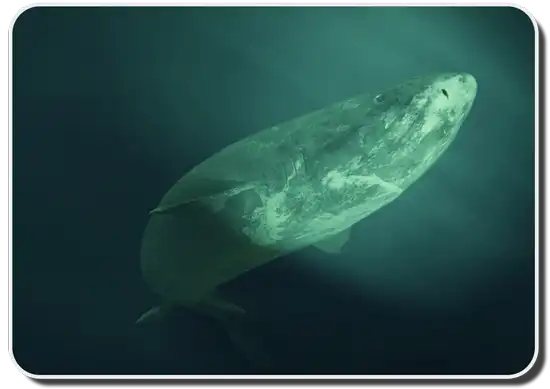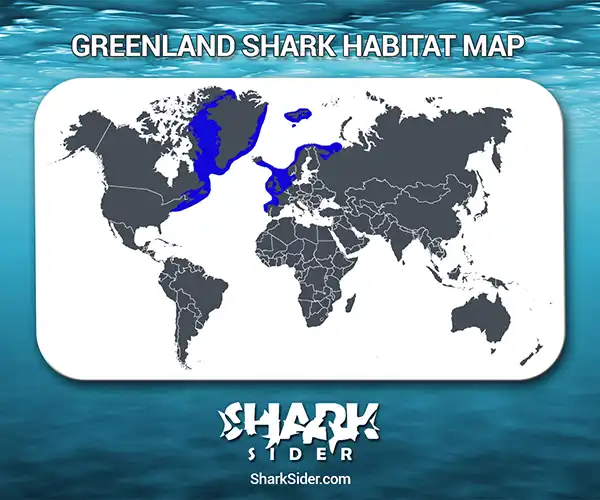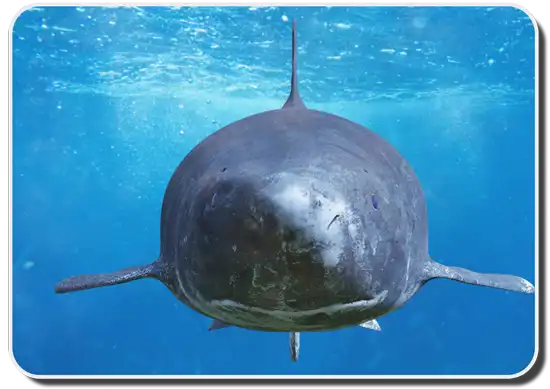Although Greenland sharks are not typically aggressive, they are most definitely some of the largest sharks on the planet. While quite a bit of mystery remains regarding this enormous and elusive fish, we have still been able to learn some interesting facts.

Appearance
To give you an idea of just how large they are, Greenland sharks usually grow up to 21 feet (6.5 meters), and they weigh approximately 2,000 lbs (900 kilos)! These usually sluggish sharks have very unique physical characteristics including their varying coloration, interesting fins, and dissimilar teeth.
Coloration
An adult can be one or more of a few different colors. These sharks can be slate gray, purplish gray, violet, brown, or black. In addition, the sides of Greenland sharks usually have a purple tint, white spots, or dark bands. In other words these sharks can be great inspiration for designers and artists!
Fins
Despite the massive sizes of these sharks, they ironically have small fins. Their little dorsal fins are equal in size, situated in the middle of the shark’s trunk, and are completely spineless. The Greenland shark’s caudal fin is asymmetrical, and although they do not own anal fins, their short, wide tails aid in short acceleration bursts.
Eyes
Another exceedingly interesting physical attribute unique to these sharks is their eyes. The eyes are very small, and they contain Spiracles behind and above them. Unexpectedly, the majority of these sharks are blind due to the fact that they have parasites hanging from their eyes. These pinkish-white parasites are called copepods, and they attach themselves to the Greenland sharks’ cornea.
Teeth
Earlier I said their teeth are dissimilar; this is because their top teeth are completely different than their bottom teeth. The teeth on the top jaw are slender, pointy, and not very large. On the contrary, the bottom row of teeth are substantially larger, broader, and smoother than those on the top row.
Diet and Hunting Behavior
Since they hunt underneath the ice in freezing cold waters, their food searches are conducted in almost complete darkness. Due to their lack of sight caused by copepod parasites, this darkness factor doesn’t make much of a difference for these sharks.
Sense of Smell
Greenland sharks have an impeccable sense of smell. Therefore, they typically have no problems finding food. They slowly wander the cold ocean looking for any scent of a dead animal or carcass.
Preferred Food Source
These sharks particularly prefer the tastes of Narwhal and Beluga whale carcasses, and they sometimes participate in cannibalism. Furthermore, these sharks also enjoy seals, cetaceans, sea lions, salmon, lumpfish, halibut, char, capelin, herring, and other fish.
Defense Mechanism
Although they feed on an extensive amount of various animals, their skin is poisonous to most other animals. For example, Inuit hunters feed on these whales, however they do not feed raw shark meat to their dogs because it causes them to behave drunkenly.
Copepod Parasites as a Hunting Aid
Many have an interesting and plausible theory concerning the connection between Greenland sharks and copepods. It is believed that these parasites somehow lure food to the sharks; once the prey is within 3 feet (1 meter) away, the shark is then able to suck the food into its mouth by inhaling. If this is indeed true, it would make perfect sense as to why the copepods are tolerated, considering that they cause blindness to the sharks. So while it’s believed these sharks mostly eat carcasses of animals who have already died, this could possibly be a way to obtain a food source when living creatures are the only treats around.
Habitat
Map Of The Greenland Shark’s Habitat

Greenland sharks inhabit freezing waters with temperatures between -2 and 7 degrees Celsius. Interestingly enough, Greenland sharks are the only species that consistently live in these arctic and sub-arctic temperature waters. During the summer months, Greenland sharks spend the majority of their time in extremely deep waters of the ocean; they can be found anywhere from 600 to 2,400 feet (180 to 730 meters) in the depths of the ocean. Contrarily, during the winter months, these sharks enjoy swimming near the water’s surface, and can often be found near the edge of ice flows.
Geographical Location
If you would like to see one of these enormous animals for yourself, they can be found in the North Atlantic Ocean from Baffin Island, to the Gulf of St. Lawrence; they can also be found as far south as the Gulf of Maine, and sometimes even in the Gulf of Mexico. Greenland sharks have also been spotted near the mouths of rivers, such as the Saguenay River in Quebec.
Reproduction and Offspring
There isn’t a lot of known information regarding the reproduction process of these sharks, however, we do know that they are Viviparous. At the appropriate time, the mother gives birth to her pups. Greenland sharks can have up to 10 pups in a litter.
Human Interaction
Fortunately, this particular species of sharks are no longer commercially harvested. In the past, these sharks were commonly hunted for their livers in Greenland, Norway, and Iceland, however this is not nearly as customary today. Inuit hunters do eat these sharks, but their meat is not a widespread delicacy for a few reasons: they are almost always in freezing waters, and their meat has to be prepared a certain way due to the fact that it is poisonous when fresh. When the sharks travel to rivers such as those in Canada, Canadian fishermen who are harvesting halibut, or other types of fish sometimes catch them. However, we can be grateful for the fact that humans have not caused the population of Greenland sharks to almost completely deplete, which is the case for so many other shark species.
10 Interesting Facts About The Greenland Shark

1. Greenland Sharks Love Cold Water
Greenland Sharks are the only true sub-Arctic shark and they live in cold waters of the North Atlantic around Iceland, Greenland, and Canada year round. Greenland Sharks prefer very cold waters with temperatures of 30.2°F-50°F (-1°C-10°C). During the summer months they will migrate deeper into the water where it is very cold, and in the winter they will swim to the surface.
2. Greenland Sharks Can And Will Eat Anything
Greenland Sharks have a voracious appetite and will eat almost anything. Typically they eat eels, lumpfish, flounder, and other small sharks, but they will also eat carrion, the meat of dead animals. They have also been known to eat land animals. Greenland Sharks have been found with a polar bear jaw, an entire reindeer, horse bones, and a moose hide in their stomachs.
3. Greenland Sharks Live A Very Long Time
Some scientists estimate that Greenland Sharks can live around 200 years. This is based on the growth rate of the sharks. Greenland sharks grow 0.2-0.4 in (0.5-1 cm) per year. So a mature 22.9 ft (7 m) shark can be assumed to be over 200 years old. So Greenland Sharks may be one of the oldest living animals on the planet.
4. Greenland Sharks Swim Very Slowly
Greenland Sharks are part of the Sleeper Shark family. Species of sharks in the Sleeper Sharks are named so because they tend to swim incredibly slowly. Greenland Sharks are one of the slowest swimming sharks on the planet, slow even for a Sleeper Shark. They tend to only move at 0.76 mph (0.3 m/s). However, they are capable of quick bursts of speed when attacking prey.
5. Greenland Sharks Can Swim Very Deep
Greenland Sharks migrate into deeper, colder waters during the summer months. During this time they can be found as deep as 7200 ft (2200 m). Scientists off the coast of Brazil believe they have observed a Greenland Shark at 9,098 ft (2,773 m) but since this is out of the range of their known habitat, it is possible it was a Pacific Sleeper Shark.
6. Greenland Sharks Have Very Unusual Teeth
Greenland Sharks have 48-52 thin, pointed upper teeth and 50-52 square, smooth cusped bottom teeth that curve sideways. The upper teeth grasp the prey while the lower teeth grind the flesh. What makes their teeth truly unusual is that like the Cookiecutter Shark, Greenland Sharks can cut a plug into the flesh of its prey. By swinging its head in a circular motion, it can use its teeth to cut out a chunk. This is extremely useful because Greenland Sharks can feed on prey that is otherwise too large to kill.
7. Greenland Sharks Are Very Mysterious
Though they have been caught and used as a food source for centuries, Greenland Sharks are rarely observed in the wild. Since they tend to swim in deeper waters and in the hostile, cold environments of the North Atlantic, humans have a difficult time seeing them in the wild. It wasn’t until 1995 that scientists were able to capture the first pictures of a Greenland Shark swimming in its natural habitat. Then in 2003, the first and only video footage of a Greenland Shark swimming was taken.
8. Greenland Sharks May Be Behind The Myth Of The Loch Ness Monster
Greenland Sharks have been observed hunting in brackish waters, so they may have a short term tolerance for fresh water, so it is possible that they could enter the Loch Ness through channels hunting for food. Greenland Sharks are also very large in size and would be a very unusual sight in the waters of the Loch Ness. So some scientists believe that the Loch Ness Monster may actually be sightings of a Greenland Shark outside of their natural habitat.
9. Greenland Sharks Are An Important Part Of Inuit Lore
Inuit peoples have many legends about Greenland Sharks. Igloolik Inuit believe that the shark lives in the urine pot of Senda, the goddess of the ocean. Another legend from the Pangnirtung Inuit states that the Greenland Shark was born after a woman washed her hair in urine and dried it with a cloth. That cloth blew into the ocean and become the Greenland Shark. The Greenland Shark is also highly respected as a helping spirit.
10. Greenland Sharks Have The Most Toxic Meat Of Any Shark
Greenland Shark meat contains a high concentration of the neurotoxin trimethylamine oxide which can cause a feeling of drunkenness if consumed. Greenland Shark meat also contains a very high level of urea, which has a urine-like odor. Their meat can only be consumed if it is boiled, dried, or fermented for several months. Greenland Shark meat is used for the national dish of Iceland, hakarl, which is noted internationally for it’s strong urine smell and unpleasant taste. Many have referred to hakarl as one of the “worst foods on the planet.”
Greenland Sharks are a truly unique species of shark.
Their massive size and unique habitat have inspired myths about them across the diverse cultures of the Northern Atlantic.
Though they are slow moving, they can be fearsome predators with a varied diet. Humans rarely observe them in their natural habitat, their toxic meat is a part of the national heritage of Iceland, so there is quite a bit known about them. These 10 interesting shark facts are just some of the things that make the Greenland Sharks a fascinating species.
